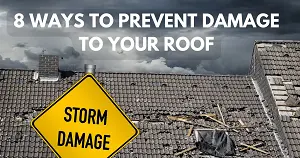When was the last time you really paid attention to your roof? For many, it is a case of ‘out of sight, out of mind.’ However, neglecting your roof can lead to severe and costly damage. As industrial roofers will be quick to tell you, prevention is better than cure when it comes to maintaining the health and longevity of your roof.
In this article titled 8 Ways To Prevent Damage To Your Roof, we will dive into practical steps you can take in safeguarding your home from devastating leaks or structural issues related to roofing damage. From tips on regular inspections by professional industrial roofers down to understanding the importance of proper insulation – if you’re a homeowner looking for peace of mind above head, then read on!
1. Keep Your Gutters Clean
Perhaps the most underrated task on your home maintenance checklist, keeping your gutters clean goes beyond just ensuring a tidy exterior. It’s indeed a chore that could end up saving you significant amounts in repairs. You might be wondering how interconnected they are, but think about it – an inefficient gutter system due to blockages is akin to simply ignoring a leaky roof. As Industrial Roofers will tell you, water damage can severely undermine the structural integrity of your roof and cost more than an arm and a leg.
Moreover, clean gutters play an essential role in managing heavy stormwater for commercial buildings. Neglected gutters can lead to water spilling over the sides which could result in ground erosion or unwanted saturation of ground causing foundational instability. That’s why so many professional Industrial Roofers now consider gutter maintenance as part-and-parcel of best practices for industrial roofing care. So remember – there’s more hanging on those few feet of aluminum than just rainwater; they stage essential defense lines against some pretty hefty damages!
2. Trim Overhanging Trees
As you sit back and take in the lush beauty of your green oasis, ever consider those branches hanging over your roof might be a lurking threat? While it’s undeniably pleasant to have tall, mature trees around your home contributing to an idyllic atmosphere, ignoring their maintenance could precipitate unwelcome occurrences. Overhanging trees can escort towards abrasive damages and obstructive wreckage like rubbed-off roof materials or clogged gutters if not timely addressed.
Thus, attentive homeowners should endeavor to trim these overreaching outlaws before they meddle more than just the aesthetic panorama. It’s not just about preserving serenity or mitigating risks—it also directly fortifies the health of your tall leafed guardians by eliminating potential disease spreaders and pest colonies. Think of it as performing two feats with one act: safeguarding a visually appealing environment while nurturing nature’s soft giants that keep our ecosystems alive! With trimmed roofs come stories of saved homes, healthier trees, and effortlessly sustained beautiful landscapes.
3. Install Proper Ventilation
When we think about our homes, often overlooked is the pivotal role of effective ventilation – especially in your roof. Enhancing the quality of air inside and ensuring your dwelling’s durability, properly installed ventilation could be a game-changer for your living space. It dispels unwanted moist air, keeping those dreaded molds and mildews at bay while also balancing out temperature variances thus reducing heating or cooling expenses.
Ventilation isn’t only about fans and windows strategically placed around the house. Your roof becomes an unsung hero when it comes to maintaining optimal airflow- surprisingly supplying over 50% of its total functional capacity! A proper vent system in your attic prevents excess heat build-up during summer while avoiding pesky condensation problems during colder months. Not just refreshing to live under but also savvy investment-wise – preserving structural integrity against premature deterioration, boosting energy efficiency and consequently escalating market value.
4. Inspect Your Roof Often
How often do you step back, pause, and take a moment to look up at your roof? Most probably the answer is rarely. This is not surprising as the roof often becomes the ‘out of mind’ component in home maintenance. However, with age, harsh weather conditions and incidents alike can harm it considerably. Regular inspection and quick repair could be the secret mantra for prolonging its lifespan. Understanding when to inspect your roof can spare you thousands of dollars in potential damage. It helps spot minor issues early before they escalate into severe problems like leakage or structural damage requiring expensive renovation or even replacement! Be it post-storm checks or seasonal assessments; roof inspection should integrate seamlessly into your routine home maintenance plan – making sure every corner of your house truly feels like ‘home’. Let’s ensure those stormy nights are about hot chocolate enjoyments rather than severe leaks identification!
5. Avoid Walking on Your Roof
Often, we yield to the temptation of striding onto our roofs, especially those few times when a Frisbee is stuck or maybe the gutters are in dire need of clearing. However, it’s crucial to resist this urge and avoid walking on your roof as much as possible! The roof is an integral part of any building structure – it not only protects us from harsh weather elements but offers structural support for our homes and offices. But trudging upon these critical structures can compromise their longevity and your safety.
Roofs aren’t designed to endure human foot traffic; each step you take could damage its tiles or shingles, leaving room for unexpected leaks or worse – a catastrophic collapse! Additionally, encountering a misstep or losing balance could lead to severe falls with life-threatening consequences. Even professionals equipped with safety gear tread lightly on rooftops! So next time the ball lands up there or when leaves clutter your gutter in autumn, remember: the risk simply isn’t worth taking. Instead consider seeking professional help who’ll circumvent these potential hazards with finesse.
6. Be Careful with Roof Mounted Equipment
Issues on roofs are frequently caused by roof-mounted apparatus. This is particularly common on commercial buildings that usually have large air conditioning units, but it’s also observed in residential properties with installations like satellite dishes. If you’re planning to install such equipment, extreme caution should be exercised to prevent even the tiniest gaps that could result in water infiltration and subsequent damage to the building’s interior. It is highly recommended to engage a professional who can guarantee a secure installation and maintain the roof’s optimal condition.
7. Keep Debris Away from Your Roof
Eliminating debris from your roof might have possibly been the last thing on your mind, but did you know that it has a significant impact on extending the durability of your roofing system? Clearing piles of leaves, twigs, and other detritus isn’t simply for aesthetic purposes. These seemingly harmless bits can trap moisture causing mold growth and unfriendly damp spots to thrive. This could potentially stress your roofing material causing premature wear and tear.
Why wait until a small problem becomes a larger one when proactively keeping debris away can save costs and risks associated with roof repair or replacement? Moreover, debris-free roofs allow seamless water flow during rainy seasons, thereby preventing potential leaks. A clean roof also decreases the opportunity for wind damage during unexpected storms. So let’s make an effort to protect not just our aesthetic appeal but also ensure robust health for our house by providing regular TLC to our roofs – starting right from the rooftop!
8. Seek Professional Advice
Undoubtedly, for optimal roof care, consulting a professional like T Samuels Industrial Roofing is your finest choice. If you’re worried about your roof’s safety, it’s always advisable to call in an experienced person to conduct a safe inspection. They possess the skills to identify potential issues and offer sound guidance on preemptive solutions before they escalate into major problems.

